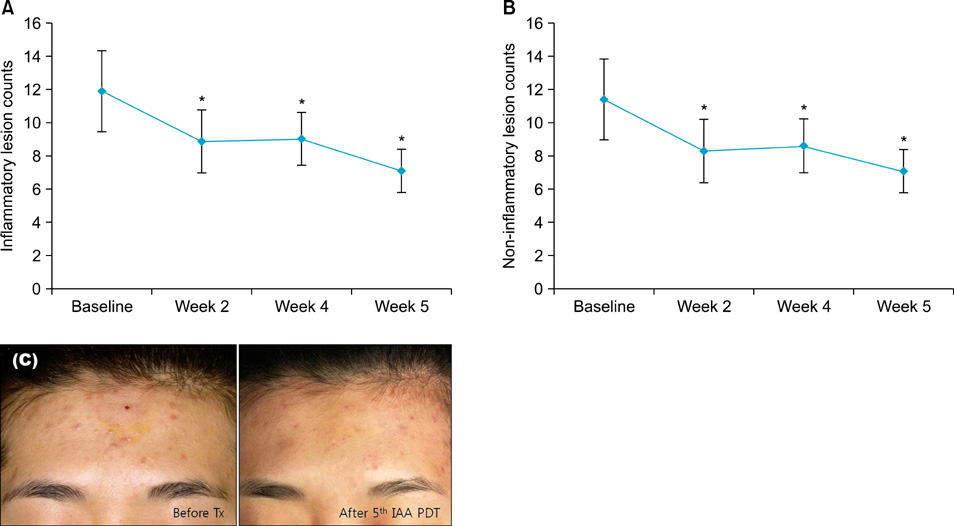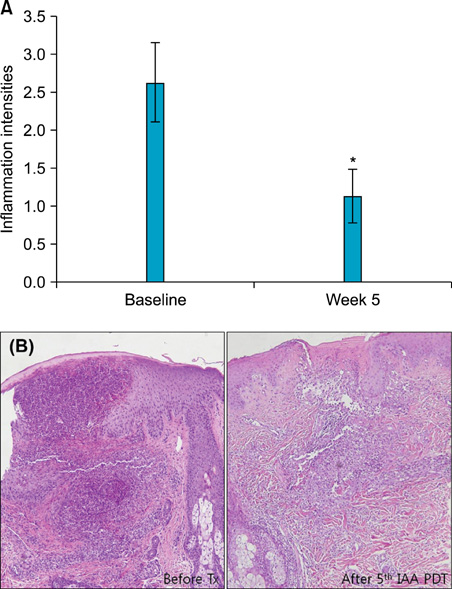Ann Dermatol.
2012 Feb;24(1):56-60. 10.5021/ad.2012.24.1.56.
The Effect of Photodynamic Therapy Using Indole-3-Acetic Acid and Green Light on Acne Vulgaris
- Affiliations
-
- 1Department of Dermatology, Seoul National University Bundang Hospital, Seongnam, Korea. gcpark@snu.ac.kr
- 2Department of Dermatology, Seoul National University College of Medicine, Seoul, Korea.
- KMID: 2156856
- DOI: http://doi.org/10.5021/ad.2012.24.1.56
Abstract
- BACKGROUND
Photodynamic therapy (PDT) using topical aminolevulinic acid (ALA) has increasingly been used for the treatment of acne vulgaris and several studies have shown its clinical efficacy. However, ALA-PDT needs a relatively long incubation period and is frequently associated with adverse effects. Indole-3-acetic acid (IAA) has been introduced as a new photosensitizer for the treatment of acne in recent study. IAA-PDT requires only a short incubation period and the procedure is relatively painless in contrast to ALA-PDT.
OBJECTIVE
To investigate the efficacy and safety of IAA- PDT in the treatment of acne.
METHODS
Twenty-five patients with facial acne lesions were enrolled in this study. IAA-PDT was performed for five sessions at 1-week intervals (week 0~4). IAA was treated with 15 minute occlusion, and green light was given for 15 minutes. Clinical efficacy was determined by evaluating acne lesion counts, severity grading, and the Dermatology Life Quality Index (DLQI) at week 0, 2, 4, and 5. Sebum secretion and erythema index was measured by Sebumeter and Mexameter, respectively, at baseline and one week after each treatment session (week 1~5). Histopathological examination was performed at baseline and week 5. Adverse effects were recorded throughout the study.
RESULTS
All the patients completed the study. Numbers of both inflammatory and non-inflammatory acne lesions were significantly decreased. Acne severity grade and the DLQI showed significant reduction. Sebum secretion and erythema were also reduced. Histopathological examination showed a reduction in inflammatory reactions. No adverse effects were observed except for transient pruritus in one patient.
CONCLUSION
PDT using IAA and green light was an effective, simple and safe treatment for acne.
Keyword
MeSH Terms
Figure
Cited by 1 articles
-
Efficacy of Red or Infrared Light-Emitting Diodes in a Mouse Model of Propionibacterium acnes-Induced Inflammation
Weon Ju Lee, Kyou Chae Lee, Min Ji Kim, Yong Hyun Jang, Seok-Jong Lee, Do Won Kim
Ann Dermatol. 2016;28(2):186-191. doi: 10.5021/ad.2016.28.2.186.
Reference
-
1. Thiboutot D, Gollnick H, Bettoli V, Dréno B, Kang S, Leyden JJ, Global Alliance to Improve Outcomes in Acne, et al. New insights into the management of acne: an update from the Global Alliance to Improve Outcomes in Acne group. J Am Acad Dermatol. 2009. 60:Suppl 5. 1–50.
Article2. Simpson N. Antibiotics in acne: time for a rethink. Br J Dermatol. 2001. 144:225–227.
Article3. Hongcharu W, Taylor CR, Chang Y, Aghassi D, Suthamjariya K, Anderson RR. Topical ALA-photodynamic therapy for the treatment of acne vulgaris. J Invest Dermatol. 2000. 115:183–192.
Article4. Itoh Y, Ninomiya Y, Tajima S, Ishibashi A. Photodynamic therapy of acne vulgaris with topical delta-aminolaevulinic acid and incoherent light in Japanese patients. Br J Dermatol. 2001. 144:575–579.
Article5. Pollock B, Turner D, Stringer MR, Bojar RA, Goulden V, Stables GI, et al. Topical aminolaevulinic acid-photodynamic therapy for the treatment of acne vulgaris: a study of clinical efficacy and mechanism of action. Br J Dermatol. 2004. 151:616–622.
Article6. Divaris DX, Kennedy JC, Pottier RH. Phototoxic damage to sebaceous glands and hair follicles of mice after systemic administration of 5-aminolevulinic acid correlates with localized protoporphyrin IX fluorescence. Am J Pathol. 1990. 136:891–897.7. Kennedy JC, Pottier RH. Endogenous protoporphyrin IX, a clinically useful photosensitizer for photodynamic therapy. J Photochem Photobiol B. 1992. 14:275–292.8. Moseley H, Ibbotson S, Woods J, Brancaleon L, Lesar A, Goodman C, et al. Clinical and research applications of photodynamic therapy in dermatology: experience of the Scottish PDT Centre. Lasers Surg Med. 2006. 38:403–416.
Article9. Na JI, Kim SY, Kim JH, Youn SW, Huh CH, Park KC. Indole-3-acetic acid: a potential new photosensitizer for photodynamic therapy of acne vulgaris. Lasers Surg Med. 2011. 43:200–205.
Article10. Goldsmith MH. Cellular signaling: new insights into the action of the plant growth hormone auxin. Proc Natl Acad Sci U S A. 1993. 90:11442–11445.
Article11. Folkes LK, Wardman P. Oxidative activation of indole-3-acetic acids to cytotoxic species- a potential new role for plant auxins in cancer therapy. Biochem Pharmacol. 2001. 61:129–136.
Article12. Kim DS, Jeon SE, Park KC. Oxidation of indole-3-acetic acid by horseradish peroxidase induces apoptosis in G361 human melanoma cells. Cell Signal. 2004. 16:81–88.
Article13. Kim DS, Kim SY, Jeong YM, Jeon SE, Kim MK, Kwon SB, et al. Light-activated indole-3-acetic acid induces apoptosis in g361 human melanoma cells. Biol Pharm Bull. 2006. 29:2404–2409.
Article14. Sung KJ, Rho YS, Choi EH, Oh JJ, Lee JH, Kim S, et al. Korean acne grading system. Korean J Dermatol. 2004. 42:1241–1247.15. Basra MK, Fenech R, Gatt RM, Salek MS, Finlay AY. The Dermatology Life Quality Index 1994-2007: a comprehensive review of validation data and clinical results. Br J Dermatol. 2008. 159:997–1035.
Article16. Wardman P. Indole-3-acetic acids and horseradish peroxidase: a new prodrug/enzyme combination for targeted cancer therapy. Curr Pharm Des. 2002. 8:1363–1374.17. Greco O, Folkes LK, Wardman P, Tozer GM, Dachs GU. Development of a novel enzyme/prodrug combination for gene therapy of cancer: horseradish peroxidase/indole-3-acetic acid. Cancer Gene Ther. 2000. 7:1414–1420.
Article18. Park KC, Kim SY, Kim DS. Experimental photodynamic therapy for liver cancer cell-implanted nude mice by an indole-3-acetic acid and intense pulsed light combination. Biol Pharm Bull. 2009. 32:1609–1613.
Article19. Kim SY, Kim MK, Kwon SB, Na JI, Park KC, Kim DS. Tumor apoptosis by indole-3-acetic acid/light in B16F10 melanoma-implanted nude mice. Arch Dermatol Res. 2009. 301:319–322.
Article
- Full Text Links
- Actions
-
Cited
- CITED
-
- Close
- Share
- Similar articles
-
- A Comparison of Red and Blue Light Emitting Diode Lights in Photodynamic Therapy for the Treatment of Acne Vulgaris
- The Role of Indocyanine Green and Diode Laser in the Treatment of Acne Vulgaris
- A Comparison of ALA-IPL Photodynamic Therapy and Acne Mode IPL Phototherapy in the Treatment of Acne Vulgaris
- Topical Aminolaevulinic Acid-Photodynamic Therapy for the Treatment of Mild to Moderate Inflammatory Acne
- Phototherapy of Acne Vulgaris with Low Level Narrow Band Red Light (680 nm)





